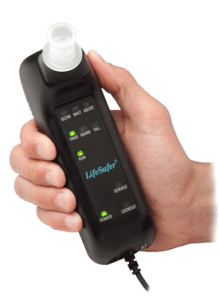 Laws requiring all impaired-driving offenders to install alcohol interlocks reduce the number of impaired drivers in fatal crashes by 16 percent, a new study by the Insurance Institute for Highway Safety shows. If all states without such laws adopted them, more than 500 additional lives could be saved each year.
Laws requiring all impaired-driving offenders to install alcohol interlocks reduce the number of impaired drivers in fatal crashes by 16 percent, a new study by the Insurance Institute for Highway Safety shows. If all states without such laws adopted them, more than 500 additional lives could be saved each year.
Alcohol interlocks are in-vehicle breath-testing units that require a blood alcohol concentration (BAC) below a certain level, typically somewhere between 0.02 and 0.04 percent, before the vehicle can be started.
More than a quarter of U.S. crash deaths occur in crashes in which at least one driver has a BAC of 0.08 percent or higher. The prevalence of impaired driving in fatal crashes has changed little in the past two decades, and interlock laws are one of the few recent policy innovations that have made a difference.
Forty-five states require interlocks for at least certain impaired-driving offenders. Twenty-eight states, the District of Columbia and four California counties have some type of interlock requirement that applies to first-time offenders.
Even when they are mandated for first offenders, interlocks come into play only after a DUI arrest, so their direct purpose is to reduce recidivism. Like other types of sanctions, however, they may act as a deterrent for those who haven’t yet committed a first offense if they are well-publicized. Either way, the overarching goal is to reduce alcohol-impaired driving and the deaths and injuries that result, and the new study shows they have succeeded.
“We looked at the number of alcohol-impaired passenger vehicle drivers involved in fatal crashes over time and compared them with the number of drivers in fatal crashes that didn’t involve impairment,” says Eric Teoh, IIHS senior statistician and the paper’s lead author. “We found that state laws mandating interlocks for all DUI offenders reduced the number of drivers in fatal crashes with BACs of 0.08 percent or higher by 16 percent compared with no interlock law.”
In 2016, the latest year for which fatal crash data are available, 10,497 people died in crashes involving drivers with a BAC of 0.08 percent or higher. Of those, 8,853 involved impaired passenger-vehicle drivers. At that time, the number of states with first-offender laws was 25. Had all states had all-offender interlock requirements in place, 543 of those deaths would have been prevented, Teoh calculated.
For the purposes of the analysis, Teoh and his co-authors grouped together two types of all-offender interlock laws: those that require all offenders, including first-time offenders, to install interlocks in order to have their license reinstated and those that only require it to drive during a post-conviction suspension. The analysis controlled for factors besides interlock laws that could affect crashes.
Laws that required interlocks for repeat offenders only cut the number of drivers with BACs of 0.08 percent by 3 percent compared with no interlock law, and that effect wasn’t statistically significant, the study showed. Laws that required them for both repeat offenders and offenders with high BACs provided an 8 percent benefit.